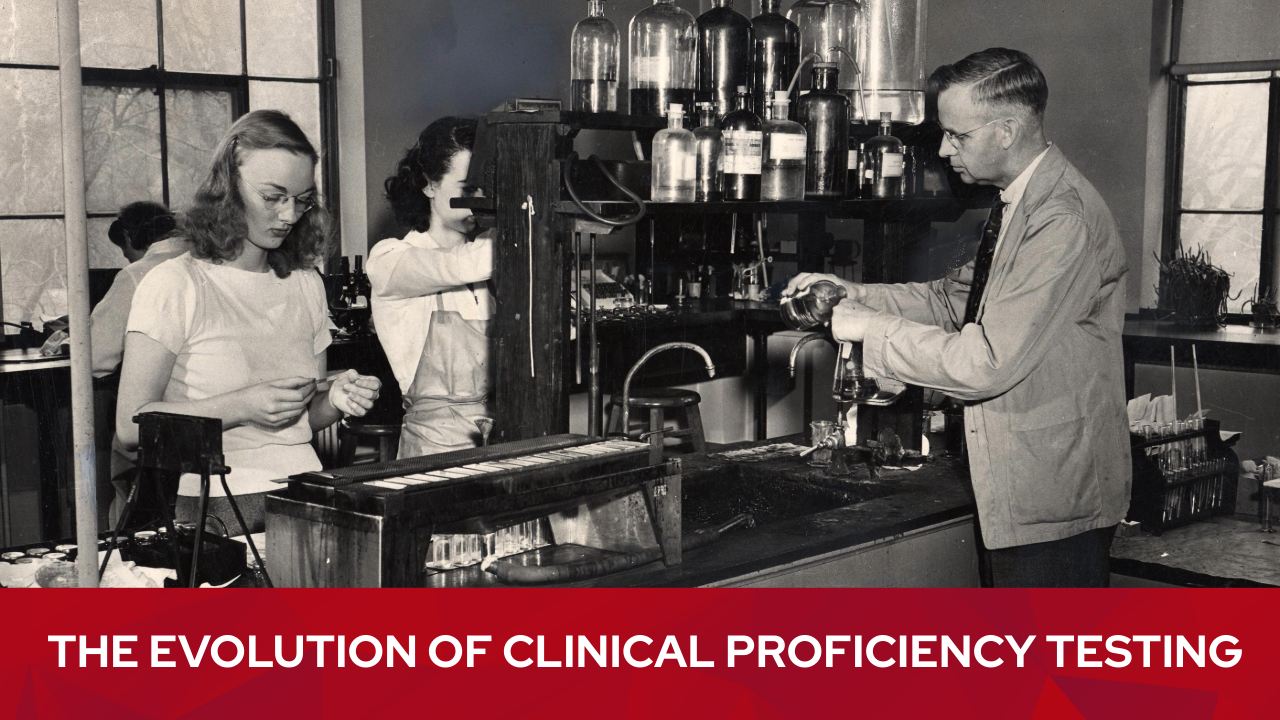
Early Days of Clinical Proficiency Testing
After the end of World War II, a well-known clinical laboratory scientist by the name of F. William Sunderman detailed his return from wartime to reassume his position as the director of the Hospital of the University of Pennsylvania. Having all experienced the shared realities of wartime, he and his other colleagues across Pennsylvania saw a need to convene and discuss mutual problems in their laboratories. Finding recurring inaccuracies in test results, that year in 1945, Sunderman and a group of laboratory professionals in Pennsylvania met and decided to distribute unevaluated serum specimens among their members and to report the results of analyses. The results revealed inadequacies so surprising that the Committee on Laboratories of the Pennsylvania Medical Society requested the members to check upon the accuracy of the more common chemical measurements made in hospital laboratories throughout the state.
The results were published in a survey, which were some of the papers used in Senate subcommittee hearings for the passage of the Clinical Laboratory Improvement Act (CLIA). This and other surveys were used to illustrate the historical need for federally regulated proficiency testing for laboratories in response to the passage of Medicare. Throughout much of the mid-century leading up to the passage of CLIA, about 2,000 clinical laboratories subscribed to participate in self-auditing proficiency testing programs coordinated largely by the Virginia Pathology Society, with endorsements by the American Society of Clinical Pathologists (ASCP) in 1952.
The early days of proficiency testing in the United States can be traced back to stories like this when medical laboratories began recognizing the need for standardization and quality control. Clinical proficiency testing, an essential component of healthcare quality assurance, has undergone significant evolution throughout history. From its rudimentary beginnings to the sophisticated systems in place today, the journey of clinical proficiency testing reflects advancements in medical science, technology, and the growing emphasis on patient safety.
The 1960s and the Rise of External Quality Assurance
The 1960s marked a turning point in clinical proficiency testing with the introduction of external quality assurance programs. Before then, there were no standardized regulations on laboratories across the United States. From its inception in 1967 to today, the Clinical Laboratory Improvement Amendments (CLIA) in the United States assure that lab tests are standardized and comparable between different labs. The first passage of CLIA in 1967 came upon the heels of the passage of Medicare in 1966, which was the first time the government was paying for health services for the elderly.
“If the government was going to pay for health services, they determined they had to have standards,” said Dr. Stanley Inhorn about the importance of Medicare in standardizing proficiency testing in the United States.
In an interview with the University of Wisconsin-Madison Oral History Program, Dr. Inhorn details his time as Director of the Wisconsin State Laboratory of Hygiene during the passage of Medicare and the creation of regulatory standards. During that same year Medicare passed in 1966, Dr. Inhorn and the rest of the leadership at WSLH established the Laboratory Improvement Division, known today as WSLH Proficiency Testing. In 1968, Dr. Inhorn was asked to come down to CDC to develop standards for laboratories that would be licensed and approved under Medicare. Along with other committee members, he developed standards for personnel and divided the tests into complex tests, intermediate tests, and tests that were called “waivered”, now known as “waived.” These early programs primarily focused on basic chemistry and hematology testing, paving the way for a more comprehensive approach to quality assurance in clinical laboratories. Dr. Inhorn has since served on the Clinical Laboratory Improvement Advisory Committee after the 1988 updates to the Clinical Laboratory Improvement Amendments that included regulatory updates to clinical proficiency testing.
Technological Advancements in the Late 20th Century
As technology advanced, clinical laboratories transitioned from manual techniques to automated instrumentation. This shift necessitated the development of proficiency testing programs that could keep pace with the evolving diagnostic landscape. The late 20th century saw the integration of molecular biology techniques, immunoassays, and advanced imaging technologies into clinical laboratories, prompting proficiency testing programs to expand their scope accordingly.
The advent of the internet in the late 20th century revolutionized the way proficiency testing was administered and managed. Online platforms emerged, allowing laboratories to participate in proficiency testing remotely. This not only increased accessibility but also facilitated real-time data analysis and feedback, enabling laboratories to address issues promptly and improve their testing processes.
The 21st Century: Personalized Medicine and Specialized Proficiency Testing
With the rise of personalized medicine and the increasing use of genomics, clinical proficiency testing has become more specialized. Laboratories are now required to demonstrate proficiency in molecular diagnostics, next-generation sequencing, and other cutting-edge technologies. Proficiency testing programs have adapted to include these specialized areas, ensuring that laboratories can provide accurate and reliable results in the rapidly advancing field of medical genetics. Looking to the future, advancements in artificial intelligence and machine learning are poised to play a significant role in shaping proficiency testing. These technologies have the potential to enhance data analysis, identify patterns, and further improve the accuracy and reliability of clinical testing.
Conclusion
While clinical proficiency testing has come a long way, challenges persist. The increasing complexity of diagnostic technologies, the need for global standardization, and the continuous emergence of new testing methodologies present ongoing challenges for proficiency testing programs.
The evolution of clinical proficiency testing reflects the dynamic nature of the healthcare industry. From its humble beginnings as a tool for basic quality assurance to its current status as a comprehensive and specialized system, proficiency testing has played a vital role in ensuring the accuracy and reliability of diagnostic testing. As technology continues to advance, proficiency testing programs will adapt to meet the challenges of an ever-changing healthcare landscape.

